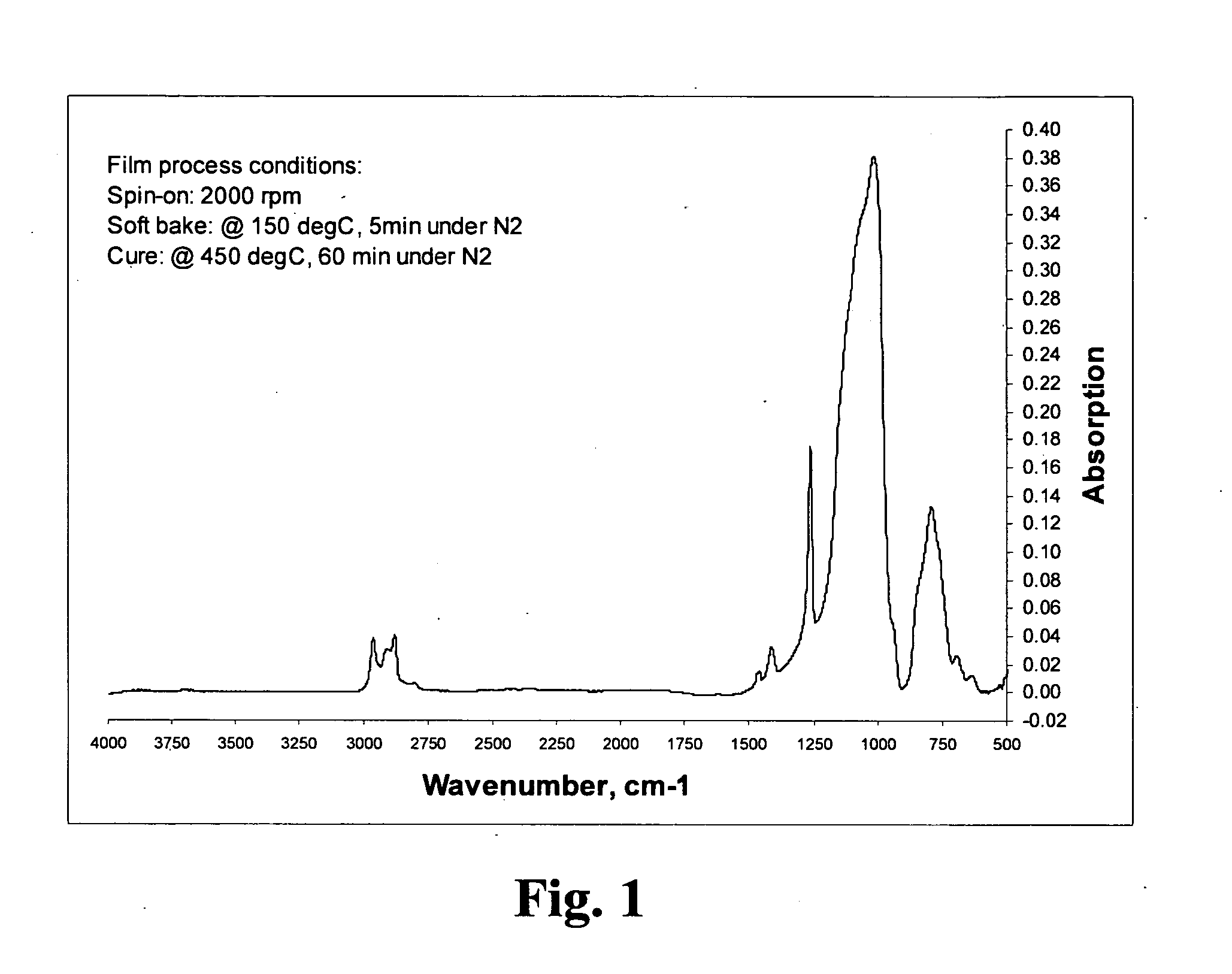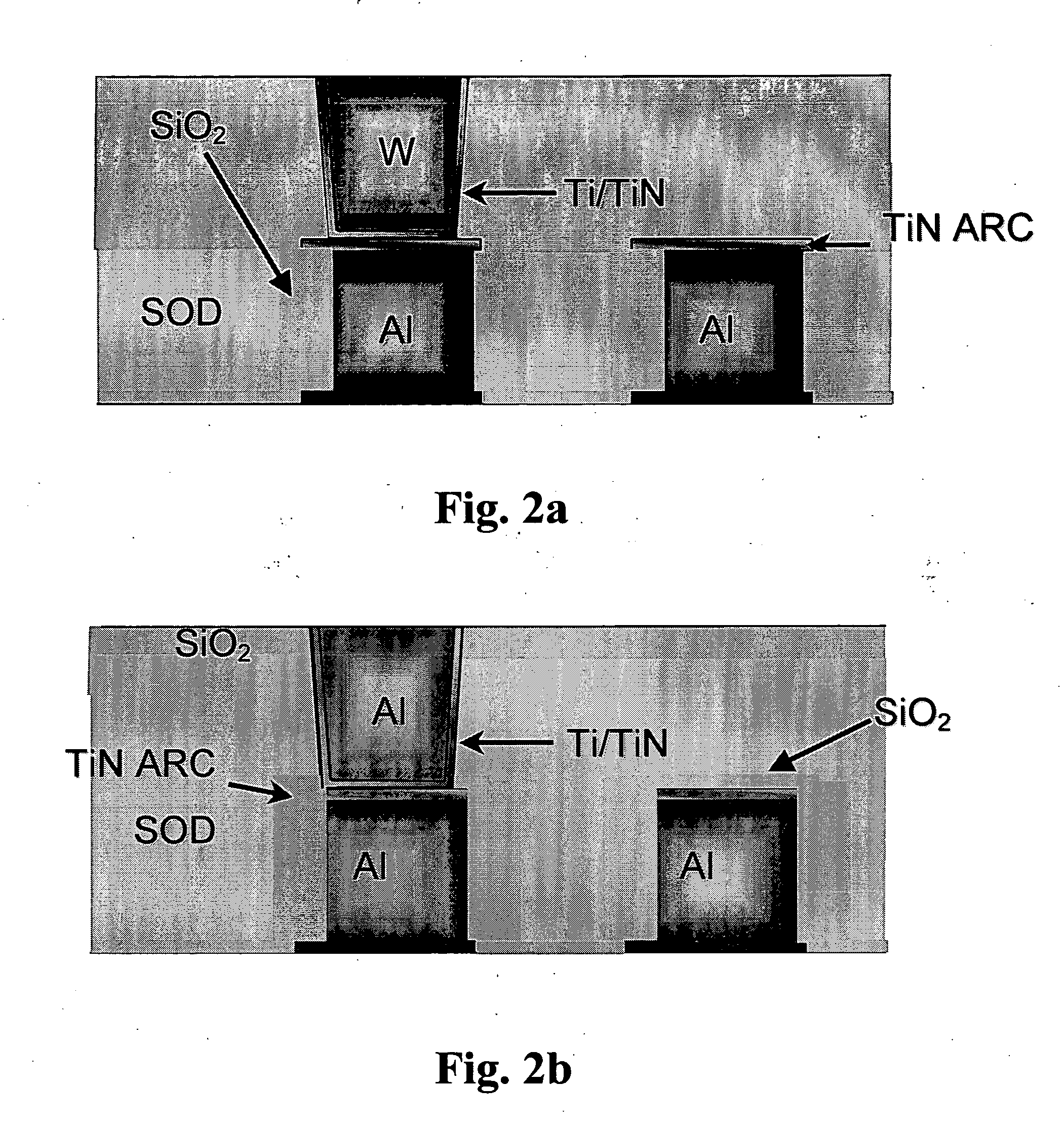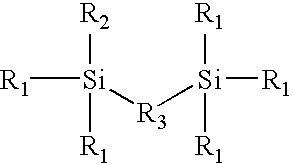Novel polyorganosiloxane dielectric materials
a dielectric material and polyorganosiloxane technology, applied in the field of thin films, can solve the problems of reducing the degree of bridging crosslinking between organic units and films, limited application of these films, and low thermal stability, and achieves excellent chemical resistance, low chemical adsorption behavior, and high cross-linking
- Summary
- Abstract
- Description
- Claims
- Application Information
AI Technical Summary
Benefits of technology
Problems solved by technology
Method used
Image
Examples
example 1
[0105] Vinyltrichlorosilane, in an amount of 142.2 g (0.880 mol), and 5 ml (5.55 g, 0.048 mol) methyldichlorosilane were introduced into a 500 ml vessel. The solution was heated up to 80° C. and 15 μl H2PtCl6 / IPA catalyst solution was added. Exothermic reaction was observed immediately and heat was switched off. Rest of the methyldichlorosilane was added in ˜20 ml portions during 30 min so that temperature of the solution did not raise over 130° C. The total amount of methyldichlorosilane was 104.2 g (0.906 mol, 2.9% excess). The solution was again heated up to 110° C. and stirred for an hour. The obtained solution was distilled. B.p. was 77° C. / 10 mbar and yield was 188 g (77%). The product, 1-(trichlorosilyl)-2-(methyldichlorosilyl) ethane, was analyzed with GC, 13C and 29Si NMR.
[0106] The synthesized molecule, 1-(trichlorosilyl)-2-(methyldichlorosilyl) ethane, (25.00 g, 0.090 mol) was weighed and dissolved to 100 ml methyl t-butyl ether (MTBE). The solution was transferred drop ...
example 2
[0114] The present invention also encompasses isomers of 1-(trichlorosilyl)-2-(methyldichlorosilyl) ethane. Methyldichlorosilane (14.9 g, 0.130 mol), vinyl trichlorosilane (21.0 g, 0.130 mol) and 100 mg tetrakis(triphenylphosphine)palladium were placed in a glass pressure tube and heated to 105° C. After ˜20 minutes, vigorous exothermic reaction too place and the solution turned dark. The content was distilled at 74° C. / 5 mbar to give 32.3 g (0.117 mol, 90%). Purity was >99% by GC. The resulting monomer was 1-(methyldichlorosilyl)-1-(trichlorosilyl) ethane.
example 3
Alternative Method for Polymer
[0115] Examples 1 and 2 describe the synthesis of two monomers, i.e., 1-(trichlorosilyl)-2-(methyldichlorosilyl) ethane and 1-(methyldichlorosilyl)-1-(trichlorosilyl) ethane, which can be used as precursors of polymers.
1(Trichlorosilyl)-2- (methyldichlorosilyl) ethane
1-(Methyldichlorosilyl)-1-(trichlorosilyl) ethane
[0116] These isomer compounds, one of which is comprising a linear linker chain and the other a branched linker chain, can be used in any ratio to form the novel dielectric siloxane polymers according to the present invention. Thus, the monomer comprising the linear linker molecule can be employed at a molar ratios of 1:100 to 100:1, preferably 80:20 to 20:80, in particular 60:40 to 40:60, with respect to the corresponding monomer comprising the branched linker molecule.
PUM
 Login to View More
Login to View More Abstract
Description
Claims
Application Information
 Login to View More
Login to View More - R&D
- Intellectual Property
- Life Sciences
- Materials
- Tech Scout
- Unparalleled Data Quality
- Higher Quality Content
- 60% Fewer Hallucinations
Browse by: Latest US Patents, China's latest patents, Technical Efficacy Thesaurus, Application Domain, Technology Topic, Popular Technical Reports.
© 2025 PatSnap. All rights reserved.Legal|Privacy policy|Modern Slavery Act Transparency Statement|Sitemap|About US| Contact US: help@patsnap.com



